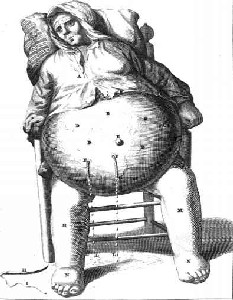
Dropsy Treatment with Scarifier and Trocar Pages: 1 2 3 4 Next>>
Dropsy Treatment with Scarifier and Trocar, Page 1
"Captain Swan, though with much Reluctance, gave way to a small Enlargement of our Commons, for now we had about ten Spoonfuls of boil'd Maiz a Man, once a Day, whereas before we had but eight: I do believe that this short Allowance did me a great deal of good, though others were weakened by it; for I found that my strength increased, and my Dropsy wore off. " (William Dampier, Memoirs of a Buccaneer, Dampier’s New Voyage Round the World -1697-, p. 195)
Dropsy, or what doctors today call endema, seems to have been a common medical concern during
period.

Woman being treated for dropsy
Fredrick Dekker, Exercitationes Practicae
Circa Mendendi Methodum (1694)
Most surgical manuals refer to a cure, none quite so thoroughly as Monsieur Dionis in
his book A Course of Chirurgical Operations, Demonstrated in the Royal Garden at Paris.
M. Dionis identifies three types of dropsy:
"The Dropsy is looked on as an unnatural Tumour, in which all the Body, or some one of its parts, is swelled to an immeasurable Bulk. 'Tis observed, that this Swelling may be produced by three several sorts of Matter; namely, by Phlegm, Wind and Water. That which proceeds from Phlegm is called Ansarca or Lencephlegmatia, a piteous Dropsy; that caused by Wind Tympaxites or a Tympany, and that formed by Water Ascites." (Dionis, p. 70)
He dismisses the build-up of Phlegm ('Ansarca') with "But in our Times we do that Part Justice, and find other Causes of this Disease, on which I shall not long dwell, any more than its Cure, which consists only of general Remedies [medicines], and without requiring the assistance of a Chirurgical Operation, it ought to be handled by an able Physician." (Dionis, p. 70-1)
He also quickly handles the build-up of wind, Tympaxites or a Tympany in fairly short order:
"If by the use of Remedies [medicines], as well general as particular, the Wind pent in the Cavity of the Abdomen does not dissipate, the Chirurgeon may make some Punctures with a Needle, as we have shown in the Pnuematomphale and Gastrorhaphy; but the Parts here being thicker than those on which the last mentioned Operations are perform'd, and the Operator having the Skin, Muscles and Peritonaum to pierce, it sometimes happens that in drawing out the Needle, these Membranes and Flesh covering again the Apertures of one another, hinder the issuing forth of the Wind; in this Case he ought to have recourse to the Trocar or Tap A, which he is to use in the same manner as I show in the Ascites [build-up of water/fluid]; for this Instrument being excavated thro' its whole length, affords the Vapours an easy Opportunity of sallying out,. 'Tis not to be drawn out 'till the Belly is wholly sunk; there being no danger in voiding all the Wind at once, as there is that of the Water which must be drawn out at several Times…" (Dionis, p. 71-2)
Dionis then takes great pains to explain ways to treat build-up of water/fluid under the skin, Ascites. Three of these methods require the surgeon to step in, which I will explain shortly. Before we get to that, I want to take a slight detour to look closer at why the pirate surgeon might be concerned with dropsies.
"Moist Scurvy" or (most likely) Beriberi

John Moyle
Endema or dropsy has a particular relevance to seamen who traveled long distances
which is related to scurvy. In discussing scurvy, John Moyle identifies two types of the disease for
his readers in his book Chirugius Marinus: Or, the Sea-Chirurgeon:
the "dry" and the "moist scurvy."
"The moist Scurvy hath more of Humid aquosity, and descends down faster from the Superior Parts to the Limbs, causing a Hydropic Tumefaction [swelling caused by water], that Pits under the Finger [when pushed into] as if a man had altogether the Dropsie, with a whiter and shining Colour of the skin: Howbeit all the other scorbutic Symptoms are here likewise." (Moyle, p. 182-3)
This sounds remarkably like the disease Beriberi, which was caused by a lack of Thiamine or Vitamin B1. (Scurvy is caused by a lack of ascorbic acid or Vitamin C.) Like scurvy, beriberi was likely to occur on ships where the diet was limited, particularly ships where rice was consumed in place of breads (or hard tack.) Its' symptoms are very close to those of Scurvy with the addition of the dropsy-like symptom of accumulation of fluid under the skin.
Zachary Friendenburg describes the symptoms of beriberi in his excellent modern book, Medicine Under Sail:
"Beriberi takes about thirty days to produce symptoms: these are lassitude (often regarded as malingering by ship's officers), weakness of muscles, and accumulation of fluid in the tissues, beginning in the legs and working upward, flooding the abdominal and chest cavities and constricting the heart. It also causes numbness and paralysis due to its effect on the nerves, along with palpitations and irregularities of the heartbeat. Palpitations of the heart and tightness of the chest, with intense pericardial pain allow the patient no rest. The brain may also be involved, and psychotic behavior may result." (Friedenberg, p. 66)
For the curious, a quick review of the symptoms of scurvy will reveal the similarities of the two diseases. Next we'll look at the treatment of dropsy using medicines and scarification.

